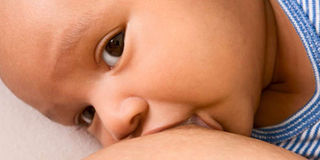Suckled or pumped? All breast milk is not equal

Milk from breastfeeding women who do not pump and milk from those who pump even infrequently differs in bacterial makeup. PHOTO | FILE | NATION MEDIA GROUP
Is breast milk suckled direct from the breast the same as expressed breast milk?
As far as the microbial makeup of the milk is concerned, research shows that the milk the baby suckles directly from the breast is different from pumped breast milk.
Milk from breastfeeding women who do not pump and milk from those who pump even infrequently differs in bacterial makeup, new research has shown.
The new research from the CHILD Cohort Study published in the journal Cell Host & Microbe, sheds light on the importance of the infant’s mouth as a source of breast milk bacteria.
The idea that breast milk has a microbiome (or microbiota) — a community of bacteria living within it — is relatively new and has sparked debate about where breast milk bacteria come from.
Some scientists believe breast milk bacteria originate in the mother’s gut while others believe they are transferred to the mother from the infant’s mouth during breastfeeding.
Direct breastfeeding was associated with microbes typically found in the mouth, a greater abundance of the beneficial Bifidobacteria, and higher overall bacterial richness and diversity.
Bifidobacteria are among the first microbes to colonise the human gastrointestinal tract and are believed to exert positive health benefits on baby.
“We found that milk bacteria are different in mothers who pump their milk,” said Dr Meghan Azad from the University of Manitoba in Canada, who led the study.
BENEFICIAL BACTERIA
“We suspect that pumping may prevent the transfer of oral bacteria from the infant to the mother and might introduce other bacteria from the pump.
“Therefore, in addition to the hypothesis that milk bacteria come from the mother’s gut, our results suggest that the infant’s oral bacteria are as important in shaping the milk microbiota.”
Further, the team found that indirect breastfeeding (defined as providing at least one serving of pumped milk in the two weeks preceding the collection of a breast milk sample for the study), was associated with a lower abundance of beneficial Bifidobacteria.
The research showed that among the many factors examined, the method of breastfeeding —whether mothers fed their infants directly at the breast or fed them pumped breast milk from a bottle — was the most consistent factor associated with the milk microbiota composition.
Dr Azad said, “We found this especially interesting because we had previously found that feeding pumped breast milk – while advantageous compared to formula – was less beneficial than nursing at the breast when it comes to protecting infants from asthma and obesity.”
In addition, direct breastfeeding without a pump was associated with microbes typically found in the mouth, as well as higher overall bacterial richness and diversity.
“Taken together, the findings suggest that direct breastfeeding facilitates the acquisition (in the breast) of oral microbiota from infants,” explained first author Shirin Moossavi, an allergen trainee and a PhD candidate at the University of Manitoba. The researchers used data from 393 mother-baby pairs in a larger dataset called the CHILD study involving thousands of Canadian children and their families.
“This study considerably expands our understanding of the human milk microbiota and the factors that might influence it,” commented Dr Azad.
“We hope the results will inspire new research about breastfeeding and human milk, especially related to pumping.”


